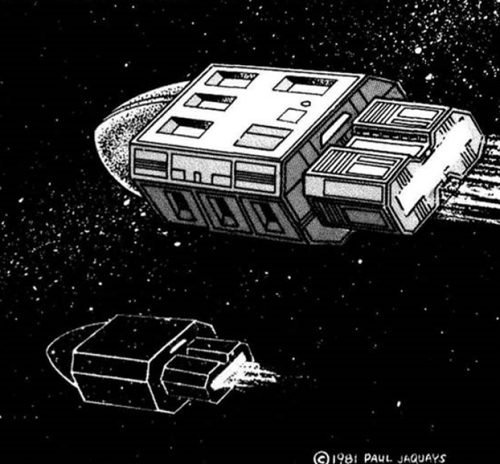Paulos class Troop Transport
| Paulos class Troop Transport | |
|---|---|
 The nose and bridge of a Paulos class Troop Transport. | |
| Type: UI Troop Transport | |
| Category | Smallcraft |
| Size | 50 Tons |
| Hull Configuration | TBD Hull |
| Streamlining | Streamlined Hull |
| Tech Level | TL–X |
| Engineering | |
| Computer | Model/TBD |
| Jump | J-0 |
| Maneuver | 3 G |
| Armaments | |
| Hardpoints | X |
| Accommodations | |
| Staterooms | 0 |
| Personnel | |
| Crew | X |
| Officers | X |
| Enlisted | X |
| Marines | X |
| High/Mid Passengers | 0 |
| Payload | |
| Cargo | X Tons |
| Fuel tank | 0 Tons |
| Construction | |
| Origin | Third Imperium |
| Year Operational | Unknown |
| End of Service | Still in active service. |
| Price | |
| Cost | MCrX |
| Architect fee | MCrTimothy B. Brown |
| Statistics | |
| Images | |
| Blueprint | No |
| Illustration | Yes |
| Source | |
| Also see | Combat Transport - Combat Transport Smallcraft |
| Canon | Published, fan design |
| Era | 1105 |
| Starships are designed with the Classic Traveller format, using High Guard. | |
The Paulos class Troop Transport is a combatant smallcraft.
- It is a military ship and a Troop Transport.
Description (Specifications)
Comments: The 50-ton troop transport was designed and produced by the Imperial Navy to meet a long-established need for deployment of troops from orbit to world surface. The 50-ton limit on displacement allows the craft to be deployed on ships having standard 50-ton launch tubes.
Each troop transport can carry 50 combat-ready troops from orbit to planet in a matter of minutes. The 10 ton cargo bay allows the simultaneous transport of vehicles, supplies, or equipment during deployment operations.
Image Repository
- Two Paulos class Troop Transports streaking to targets, one engaging its non-standard stealth device.

General Description & Deck Plans
No information yet available.
Basic Ship Characteristics
Following the Imperial Navy and IISS Universal Ship Profile and data, additional information is presented in the format shown here. The small craft factor indicates the number of squadrons (of ten craft) carried on the ship. Tonnage on the universal ship profile is shown in kilotons (thousands of tons) when necessary. [1]
| Basic Ship Characteristics [2] | ||
|---|---|---|
| No. | Category | Remarks |
| 1. | Tonnage / Hull | 0-99 tons. |
| 2. | Crew | x1 crew. |
| 3. | Performance | Propulsion: |
| 4. | Electronics | Model/TBD fib ship computer. |
| 5. | Hardpoints | xTBD hardpoints. |
| 6. | Armament / Weaponry | The normal weapons fit-out for it is:
|
| 7. | Defenses | Defensive Equipment:
|
| 8. | Craft / Drones | None |
| 9. | Fuel Treatment | None |
| 10. | Cost | MCrTBD. |
| 11. | Construction Time | TBD months to build, TBD months in quantity. |
| 12. | Remarks | Other Equipment: |
History & Background (Dossier)
No information yet available.
Class Naming Practice/s & Peculiarities
No information yet available.
Selected Variant Types & Classes
Combat Transport Smallcraft - Smallcraft - Troop Transport:
References & Contributors (Sources)
| This article has metadata. |
| This article is missing content for one or more detailed sections. Additional details are required to complete the article. You can help the Traveller Wiki by expanding it. |
| The ship, vehicle, equipment, or other technology in this article wasn't given a specific, distinctive name upon first publication. FFE has given the wiki permission to name this generic setting detail in order to better catalogue it. Names are chosen a wiki administrator based on personal preferences.
You can help the Traveller RPG Wiki by letting the wiki administrators know if the item has a name that wasn't published, was omitted accidentally from publication, that you are familiar with, or might have been popularly known within the greater Traveller community. |
- Marc Miller, Frank Chadwick, John Harshman. High Guard (Game Designers Workshop, 1980), 20-37. (Design Sequence Used)
- Timothy B. Brown. Fighting Ships (Game Designers Workshop, 1981), 24. (Classic Traveller Supplement 9)
- Traveller Wiki Editorial Team
- Author & Contributor: Lord (Marquis) and Master of Sophontology Maksim-Smelchak of the Ministry of Science
- ↑ Timothy B. Brown. Fighting Ships (Game Designers Workshop, 1981), 10.
- ↑ Timothy B. Brown. Fighting Ships (Game Designers Workshop, 1981), 10.